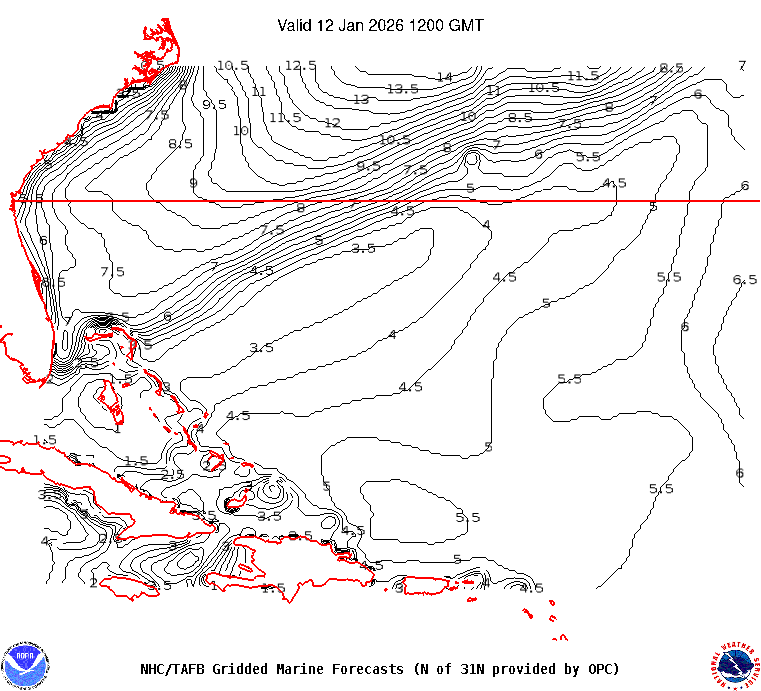FLORIDA EAST COAST MARINE WEATHER (heavily edited by Dean)
The region will be between a trough to the northeast, and building high pressure to the west northwest through Friday, resulting in breezy conditions over area waters and Small Craft Advisory conditions. The high will build overhead Saturday, with high pressure ridging then prevailing into next week with surf trending downward to near flat.
DEAN’S 7-DAY SURF FORECAST
FRIDAY(22Nov): Cold in the morning (low 40’sF) with wind continuing from the NW/WNW 9-16 mph and waves 1/2-occ 1′ (still+ south am) in mixed period, (5-occ/inc 11 sec) N/NE swell. High temp won’t get out of the mid-60’sF and the wind will make it feel even colder, setting up the coldest night (to date) of fall.
SATURDAY: At the time of updating the forecast, it looks like it will stay very small/cold with only a hint of inconsistent N/NE swell at times, and the chilly offshore wind will be lighter with waves 1/2-occ 1′ (+/-0.5′) with a morning low in the low 40’sF to start the weekend, with no signs of significant improvement until late next week.
SUNDAY: !/2′ to near flat. After another very cool morning around 50F and surf temps flirting with the upper 60’sF, a gradual warming trend will get underway, though the onshore wind off the much cooler Atlantic will keep temps at the beach in the low to mid 70’sF.
MONDAY(25Nov): Warming up, but still near flat to flat. Watching forecast models for hope.
TUESDAY: Lake Atlantic please wake up!
WEDNESDAY: Starting out near flat, with minor improvement in mixed period east swell possible late.
THANKSGIVING DAY(28Nov): Some minor improvement likely in E/SE swell. Will put numbers on the call when confidence is better.
FRIDAY: Models suggest a weak/dry “back-doorish” cold front will push through during the day and high pressure will build behind it, producing an increase in north wind, veering NNE late with waves gradually responding toward evening.
SATURDAY: Onshore flow increases and clocks NE, building surf to 1.5-2.5′ in close period (5-6 sec) choppy NE wind swell.
SUNDAY(1Dec): Onshore wind continues while clocking more east and surf size levels off at 1.5-occ 2.5′ in moderate period (7-8 sec) ENE swell.
Use the local buoy 40 miles offshore from St. Augustine to determine swell arrival in a matter of several hours. Further ESE out in the Atlantic, the NE Bahamas buoy #41047 and buoy #41046 east of the central Bahamas broke free of their moorings during the flurry of tropical activity this hurricane season and are currently adrift in the Atlantic. Until these buoys are restored, buoy # 41049 300 nautical miles SSE of Bermuda may be monitored for fetch/duration of easterly swell to estimate the wave potential a day or two ahead.
Thankfully, buoy #41002 225 nautical miles south of Hatteras remains moored to the sea floor and will continue to indicate (about a day in advance) increases in NE/ENE wind and swell over the offshore waters due to cold fronts and associated low pressure areas pushing off the mid-Atlantic coast in the fall and winter. The Edisto buoy 41 nautical miles southeast of Charleston and the Grays Reef buoy 40 nautical miles southeast of Savannah are good indicators for the potential (around half of a day or so) arrival of N/NE wind and wind swell behind cold fronts pushing down and off the South Carolina and Georgia coasts, then eventually into northeast Florida.
7-10 DAY WEATHER OUTLOOK (with tropical weather discussion)
No systems formed in the tropical Atlantic basin during the second half of August, and activity remained uncharacteristically subdued until after Labor Day in early September. This eerily quiet (for historic heart of activity) suddenly exploded when a flurry of tropical storms and strong hurricanes spun throughout the basin. Following Raphael’s walloping of Cuba before gradually fading in the Gulf w/o another landfall, areas continue to be monitored by the NHC, and one or two more named storms could develop during the next couple of weeks in the Caribbean portion of the basin before Thanksgiving Day. This Atlantic basin infrared loop illustrates the few areas of convection that manage to flare up in the eastern and central Atlantic basin continue to generally fizzle out before progressing very far to the west.
Given the tremendous impact Helene and Milton have had on Florida as the long road of recovery continues for the hardest hit areas, it is difficult to imagine another tropical system spinning up in the western Caribbean Sea in the coming weeks, Multiple model runs of the GFS suggested a Tropical Storm Sara will slowly develop in the western Caribbean Sea over the weekend. The system is forecast by most global models to not reach hurricane status due to time spent near and over land in central America, and it should weaken to a tropical low by the time it enters the Gulf of Mexico next week. After that, the low is forecast to track north then NE and be absorbed by a strong cold front that will sweep across the Florida peninsula later in the week.
Locally, Atlantic near-shore ocean temperatures that had been running several degrees above normal since spring decreased in October to near seasonal normal in the mid-70’s post-Milton. However, with the exceptionally warm first 10 days in November, surf temps and Elsewhere in the Atlantic basin, SST’s in the western Caribbean Sea are still in the low to mid-80’s, well above normal, though most of the Gulf of Mexico cooled significantly and are running below normal due to Major Hurricanes Helene, Milton and Raphael. The Caribbean Sea and western Atlantic, as well as the Florida Straits and central/north Bahamas, are still open for business in November given lingering favorable available oceanic latent heat and available moisture- though shear has increased and periodic/brief dry air intrusion following cold fronts are at times unfavorable in these climatologically favored regions for fall tropical cyclogenesis. Given the forecast for significant cold fronts to start pushing through the state the last 10 days of November into early December, the potential for tropical activity will be greatly reduced as the season “officially” draws to a close on the 30th… Stay tuned for updates!
NWS Coastal Waters/Weather Forecast Links
St. Augustine to Flagler Beach
NWS Jacksonville Coastal Forecast
New Detailed NWS Wave Forecast handout
NOAA upgrading nearshore wave prediction
7-day St. Augustine buoy sea height forecast (primary swell).
Florida Coastal Forecast Map (click on zone)
Marine Page for SE Georgia/NE Florida
_________________________________________________________________________________________
This graph illustrates the 14-day forecast for primary swell height and period for the St. Augustine offshore buoy:
St Augustine buoy 14-day forecast
This map illustrates sea height contour (in feet) for the near shore Atlantic Ocean east of Florida:


 ______________________________________________________________________________________________________
______________________________________________________________________________________________________Sea surface temps in the GOMEX and western Caribbean Sea.
Watch this GOES loop for lightning signatures that indicate intense convection.
______________________________________________________________________________________________________
The NHC Atlantic Tropical Weather Discussion and the tropical western Atlantic satellite loop are good tools to monitor the Atlantic basin for activity. Good links (updated regularly) to excellent private websites with forecast discussions monitoring tropical and non-tropical weather impacting Florida and the eastern US: Central Florida Hurricane Center and WeatherBELL
Here is a link to the impact hurricane activity has on our coast: Florida beaches face sand shortage
El Nino Southern Oscillation (ENSO) Discussion

